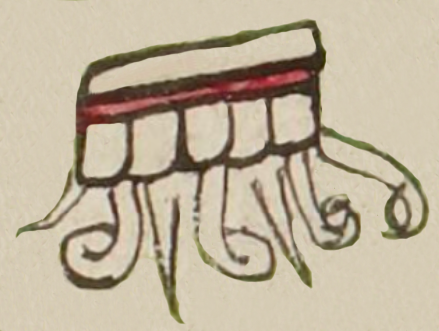tlatolli (TR25v)
This element for word or statement (tlatolli, or tlahtolli, with the glottal stop) has been carved from the compound glyph for the place name Tlatoltepec. It shows a set of upper teeth (tlantli) with a red gum and perhaps a white bone above the teeth, providing a phonetic indicator for tla-, while also providing the semantic context for the word to emerge. Below the teeth, spikes and curls appear, and these are the focus of the noun tlatolli.
Stephanie Wood
Speech scrolls that come out of a human mouth (also, for instance, from an eagle's beak) can represent a range of vocabulary, including: tlatolli (word), itoa (to speak), tzatzi (to announce), motenehua (aforementioned), nahuatl (language, or a pleasant sound), chalani (to speak a lot), and cuica (to sing). This list is not exhaustive.
It is interesting that "word" is represented as oral rather than alphabetic or hieroglyphic. Oral communication was paramount in Nahua culture.
Stephanie Wood
ca. 1550–1563
words, palabras, to speak, hablar, teeth, dientes, volutes, volutas, scrolls, hueso, huesos

tlatol(li), word, statement, https://nahuatl.wired-humanities.org/content/tlatolli
la palabra
Stephanie Wood
Telleriano-Remensis Codex, folio 25 recto, MS Mexicain 385, Gallica digital collection, https://gallica.bnf.fr/ark:/12148/btv1b8458267s/f76.item.zoom
The non-commercial reuse of images from the Bibliothèque nationale de France is free as long as the user is in compliance with the legislation in force and provides the citation: “Source gallica.bnf.fr / Bibliothèque nationale de France” or “Source gallica.bnf.fr / BnF.”




